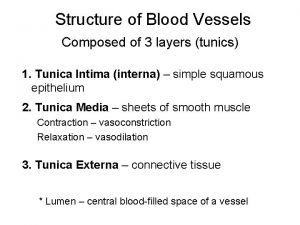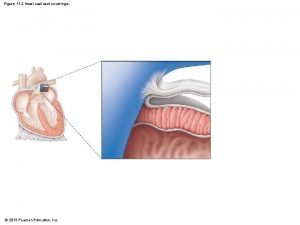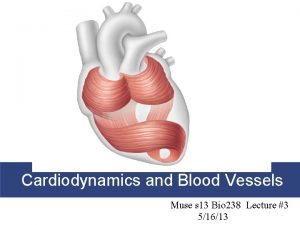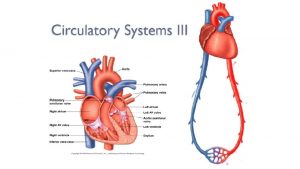Major Arteries of the Systemic Circulation Major Arteries













- Slides: 13

Major Arteries of the Systemic Circulation

Major Arteries of the Systemic Circulation • Aorta - It is the largest artery of the body - Different parts of the aorta are named for their location or shape: Ascending aorta -> Aortic Arch -> Descending Thoracic Aorta -> Abdominal Aorta

Arterial Branches of the Ascending Aorta • The only branches of the ascending aorta are the right and left coronary arteries, which serve the heart

Arterial Branches of the Aortic Arch • Brachiocephalic artery: The first branch of the aortic arch - Brachiocephalic artery splits into the R. common carotid artery and R. subclavian artery • Left common carotid artery is the second branch of the aortic arch • Left subclavian artery: the third branch of the aortic arch

Arterial Branches of the Aortic Arch • The right common carotid divides into the R. internal carotid that serves the brain and the R. external carotid that serves the skin and muscles of the head and neck • The left common carotid divides the same way as the right common carotid

Arterial Branches of the Aortic Arch • The subclavian branches into the vertebral artery, which serves part of the brain • In the axilla, the subclavian artery becomes the axillary artery and then continues into the arm as the brachial artery which supplies the arm

Arterial Branches of the Aortic Arch • At the elbow, the brachial artery splits to form the radial and ulnar arteries, which serve the forearm

Arterial Branches of the Thoracic Aorta • The intercostal arteries (ten pairs) supply the muscles of the thorax wall • Other branches of the thoracic aorta supply the lungs (bronchial arteries), the esophagus (esophageal arteries), and the diaphragm (phrenic arteries)

Arterial Branches of the Abdominal Aorta • The celiac trunk is the first branch of the abdominal aorta - It has 3 branches: 1. Left gastric artery: supplies the stomach 2. Splenic artery: supply the spleen 3. Common hepatic artery supplies the liver

Arterial Branches of the Abdominal Aorta • The unpaired superior mesenteric artery supplies most of the small intestine and the first half of the large intestine or colon • The inferior mesenteric artery is a small unpaired artery supplying the second half of the large intestine • The renal (L and R) arteries serve the kidneys c

Arterial Branches of the Abdominal Aorta • The gonadal (R and L) arteries supply the gonads: they are called the ovarian arteries in females and the testicular arteries in males • The lumbar arteries are several pairs of arteries serving the heavy muscles of the abdomen and trunk walls c

Arterial Branches of the Abdominal Aorta • The common iliac arteries (L and R) are the final branches of the abdominal aorta: - each divides into an internal iliac artery, which supplies the pelvic organs and an external iliac artery which enters the thigh where it becomes the femoral artery - The femoral artery and its branch, the deep femoral artery serve thigh c c

Arterial Branches of the Abdominal Aorta • At the knee, the femoral artery becomes the popliteal artery, which then splits into the anterior and posterior tibial arteries, which supply the leg and foot • The anterior tibial artery terminates in the dorsalis pedis artery, which supplies the dorsum of the foot c c
 Major arteries of the ascending aorta and aortic arch
Major arteries of the ascending aorta and aortic arch Arteries of the systemic circulation
Arteries of the systemic circulation Hepatic blood flow
Hepatic blood flow Structure of blood vessels
Structure of blood vessels Respiratory zone structures
Respiratory zone structures Figure 11-7 veins labeled
Figure 11-7 veins labeled Overview of the major systemic arteries
Overview of the major systemic arteries Major systemic arteries labeled
Major systemic arteries labeled Correctly label the following major systemic arteries
Correctly label the following major systemic arteries Overview of the major systemic arteries
Overview of the major systemic arteries Major arteries and veins of the systemic circuit
Major arteries and veins of the systemic circuit Label the major systemic arteries
Label the major systemic arteries Systemic circulation flow chart
Systemic circulation flow chart Bronchi diagram
Bronchi diagram

























